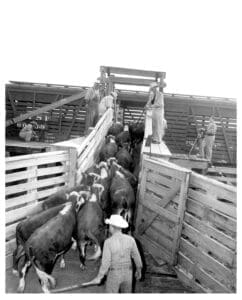By Blaine Davis, Contributing Editor
After finishing a second cocktail made from my favorite new libation, Boot Hill Distillery’s “Red Eye Whiskey,” I made a marketing decision about the remainder of 2016’s corn crop. While this method wasn’t conventional compared to the teachings of my college days, I did catch an upswing in prices and faired better than the previous 30 day’s market. With large carryovers of last year’s crops and the actions of the Boards of Trade suspect at best, commodity selling could be likened to beating “the house” in Las Vegas. The house always wins.
Thinking about 2017 crops and what to do next has me reflecting on marketing techniques applied throughout my architecture career. My firm’s founder, Howard T. Blanchard, professed, “If you needed 10 projects to fulfill your year, you had better go after 100.”
I’d like to think I had better odds, but like farming, this deck can be stacked against you. Throughout my more than 30 years of going after construction projects, strategies such as that proved to be both time and resource consuming. As a smaller staffed sole proprietorship, competing with larger firms with designated marketing specialists becomes a long shot. Tracking the expenses associated with my time and that of promotional materials to pursue just one prospect can approach several thousand dollars. With the odds Blanchard gave, a void similar to a large sink-hole can easily appear in my financial statement.
Marketing my 2017 wheat crop is similar to the long odds for achieving architectural success. Having all available dryland fields in fallow from fall crops, the input costs of irrigating wheat, the summer’s ominous clouds bearing hail storms, potential yields only slightly better than that of dryland and a depressed market price all made for tough odds. The marketing decision, like passing on a long-shot architectural commission, was made last fall not to plant any wheat at all. For the first time in over three generations, our family farm wasn’t planting wheat and, considering the spring blizzard that struck western Kansas late April, combined with the afflictions of wheat strip mosaic and rust, this decision looked even better.
With more acres of corn and soybeans though, marketing is ever challenging, causing me to scratch my head, re-think my position and revive some of my past marketing strategies, as if I drew two new cards to my hand. Thinking back 30 years, Gerald R. Carter, AIA, and then the University Architect at my alma mater, shed some light on marketing strategies for small architecture practices like mine. Could this very basic process shed similar light to that of farm commodities? At the heart of this strategy was matching the architect’s abilities and skills as a product to sell to the desired market. For example, having vast experience in concrete parking structures might lead to a sale as a coastal residential designer employing similar techniques with concrete to withstand hurricane-force winds and rain.
Comparable to this, a farmer might approach a market based on his land’s abilities as a product, such as soil type, climate, available water and proximity to an end-user. For Gray County Kansas farmer Darrell Strawn, such a strategy has begun with implementation of Tierra Del Sol Vineyards. Meaning “land of the sun,” it’s a fitting name for such a Kansas venture. Comparing their farm’s soils, rainfall and other conditions to those in France, the similarities lead them to plant two tracts with five varieties of grapes. Gray County’s annual 20-inch rainfall is ideal as the additional required 10 inches can be applied by efficient use of drip-irrigation. With the dry western Kansas climate, fungus that can afflict a grape crop is minimized.
Raising grapes in Kansas may appear to the average person as risky as sitting down with a card shark, but as written by Carolyn Johnson in The Legend, Life in Southwest Kansas magazine, before Prohibition, Missouri was ranked number one in the nation for the most vineyards. Kansas was a close second.
A state more known for cattle and oil wells, Texas has become a major grape- and wine-producing area. The Texas High Plains Appellation, totaling 8 million acres, produces 80 percent of Texas’s grapes in conditions similar to those of western Kansas. Starting in the 1970s with inspiration from several professors at Texas Tech University, this region with its hot, dry summers and cool evenings produces quality fruit that retains more natural acidity. Successes and notoriety from awards such as a 1984 Double Gold Medal from San Francisco’s Fair, lead more farmers to plant larger acreages of grapes as an alternative to common crops of cotton, corn and sorghum.
Not known for my prowess with a deck of cards or mastering the roll of dice, the gamble of pursuing of an architectural commission or a profitable price for a corn crop is like drawing to an inside straight. While enjoying a glass of Texas wine and its representation of a new marketing strategy, I say deal me in.





